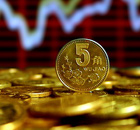Top Biz News
Fed keeps eyes out for speculative bubbles
(Agencies)
Updated: 2010-04-07 05:50
 |
Large Medium Small |
WASHINGTON - Federal Reserve officials at their March meeting stressed the need to make sure record-low interest rates don't feed new speculative bubbles in stocks or other assets.
At the same time, some officials said the Fed's pledge to keep rates low for an "extended period" doesn't mean a fixed period of time. Rather, it depends on the strength of the economy, according to minutes of the closed-door meeting released Tuesday. Many analysts have taken the pledge to mean rates would stay at record lows for roughly six months to help underpin the recovery.
The Fed officials argued that the pledge won't stop the Fed from boosting rates if the economy showed signs of picking up substantially or if inflation took off. On the other hand, the pledge "could last for some time" if the economy took a turn for the worse.
A few members thought the risks of boosting rates too soon exceeded the risks of doing so later. To aid the recovery, the Fed at its March 16 meeting held the target range for its bank lending rate at zero to 0.25 percent. It's stood at that level since December 2008. And it maintained a pledge _ in place for a year _ to keep rates at rock-bottom levels.
Thomas Hoenig, president of the Federal Reserve Bank of Kansas City, for a second straight meeting was the sole member to oppose keeping that pledge. Analysts saw Hoenig as concerned that holding rates too low for too long could feed some new speculative bubble in assets such as stocks or commodities.
Information collected by Fed staff hasn't revealed significant threats in the financial markets or widespread high-risk-taking, the minutes concluded. Still, Fed officials said they would be on the watch for any such threats.
The Fed, though, has been attacked on Capitol Hill and elsewhere for failing to detect risks leading up to the financial crisis. Under various proposals to revamp the financial regulatory system, the Fed could win some powers and lose others.
Some also blame for the Fed for feeding the housing bubble that eventually burst and plunged the country into the worst recession since the 1930s. Critics contend the Fed did so by holding rates too low for too long after the 2001 recession.
On Wall Street, the Dow Jones industrial average, which initially rose after the release of the Fed minutes, closed down nearly 4 points to 10,969.99. Broader stock averages eked out small gains.
A major challenge for the Fed is deciding when to boost rates. Moving too soon could hurt the recovery. But waiting too long could unleash inflation.
Hoenig favored dropping the "extended period" pledge. He would replace it with language saying economic conditions warrant low rates for "some time." Hoenig suggested such a change would give the Fed flexibility to begin raising rates modestly when the time was right, the minutes explained.
Hoenig said he believed the Fed would need to start boosting rates "sooner rather than later."
Brian Bethune, economist at IHS Global Insight, said the thrust of the Fed minutes suggested policymakers would continue to hold rates at record lows at their next meeting on April 27-28 and probably for most of this year.
The Fed has leeway to hold rates low because inflation isn't a threat. Most Fed officials believed substantial "slack" in the economy would continue to tamp down inflation pressures, the minutes said.
By slack, Fed officials mean the fact that factories and other businesses are still operating below full throttle and that the job market _ while improving _ remains weak. Workers won't be able to negotiate sizable pay raises or other compensation any time soon.
Companies will be hard-pressed to ratchet up retail prices when shoppers are reluctant to go on spending sprees. All those forces should keep inflation in check.
In fact, Fed officials saw recent inflation readings as suggesting "a slightly greater deceleration" in consumer prices than expected.
Assessing economic conditions, the Fed again said the economy was strengthening. But it cautioned that high unemployment, sluggish income growth and tight credit will restrain the recovery. And some members said the rebound might fade if significant job creation doesn't occur.
Despite some improvements at the end of last year and heavy government support, housing activity appeared to be "leveling off." Home foreclosures are also likely to stay quite high, the Fed said.
Separately Tuesday, Narayana Kocherlakota, president of the Federal Reserve Bank of Minneapolis, suggested in a speech that the economic recovery will last even without a major turnaround in the housing market.
Once the recovery is entrenched, Kocherlakota also thinks the Fed will be able to gradually sell some of its vast holdings of mortgage securities to reel in money pumped out during the financial crisis. The Fed would do so when it decides to tighten credit.
If the Fed sold $15 billion to $25 billion of securities a month, it would take roughly five years for it to unload all the mortgage securities it bought during the crisis, Kocherlakota said. Such gradual selling, he said, would have "little or no impact" on the prices of the mortgage securities or on long-term mortgage rates.














